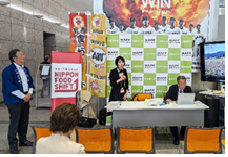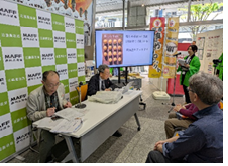Kinki Regional Agricultural Administration Office Kansai Food “Wa” Marche Report on the end of the seminar at the Yomiuri Shimbun Osaka Headquarters
Yoshie Doi
 |
 |
 |
Kinki Regional Agricultural Administration Office Kansai Food “Wa” Marche Venue
On April 22, 2025, the Kinki Regional Agricultural Administration Office Kansai Food “Wa” Marche was held in the lobby on the first floor of the Yomiuri Shimbun Osaka Headquarters, and Kyo-Suzume was in charge of two seminars. The five of us, Kenichi Hasegawa (head of Aburimochi Ichiwa), representative of the Okudosan Miraishu, Junji Miyaoku (Miyaoku Plastering Industry), also a member of the Miraishu, Hideaki Takemoto, also known as the rice cooker Meibei, Yoshie Doi, and Masami Otani, gave a relay presentation.
Although I have had the opportunity to hear each speaker speak individually many times, this was the first time that we had a relay presentation format.
First, Doi spoke about “Why do we use okudosan in this age of electricity and gas?” The reason is that the rice tastes good. As a Japanese person from Mizuho, we wants people to eat delicious rice in the way that it was meant to be, so we held the okudosan summit and is carrying on the okudosan culture. The okudosan also has a natural circulation system. We also talked about how the okudosan was the center of family gatherings, how the traditional value of okudosa is a bridge to cutting-edge science, and how the culture of fire is the culture that has evolved humanity.
We also showed photos of stores and homes that still use Okudosan, and introduced the Okudosan Summit and the Okudosan Future Conference.
Mr. Kenichi Hasegawa, the head of Aburimochi Ichiwa, which was founded in the year 1000, is the world’s oldest surviving restaurant. The restaurant has been making food for over a thousand years using the same well water, an okudosan (stove), and the same recipe. Through the restaurant’s philosophy, he protects the well and okudosan that were cherished by his ancestors. He said that the year 1000, when the restaurant was founded, is the time when Imamiya Shrine was founded. He also said that the origin of Aburimochi is linked to the oral tradition that Okachin (a word derived from “kachiii,” the noble wife’s word for “mochi”; “kachi” means to pound mochi, and “ii” means rice, which means glutinous rice) was a specialty of Koryuji Temple (now nonexistent), which was located on the northwest foot of Mt. Funaoka and is said to be the origin of Aburimochi, was offered to the god of plague. He said that even today, the custom of offering glutinous rice steamed at Ichiwa as a sacred offering continues to this day in the portable shrine of the Imamiya Festival. It was a story that gave a sense of history.
Junji Miyaoku, the maker of the okudosan, showed us a video of the process of making the okudosan, and talked about how the okudosan, which is made by fermenting natural soil and straw, conforms to the laws of nature. It was a valuable talk about how he actually makes and repairs okudosan on site. It was a talk about the keywords of inheriting the okudosan culture.
Next, Hideaki Takemoto talked about how to cook delicious rice. He talked about the traditional way of cooking rice and the role of the okudo-san in times of disaster, and finally, Masami Otani explained about trademarks and his love letter to Kyoto.
The end of document
Translated by Masami Otani
